The rare and beautiful Monstera albo created an immediate sensation when it first arrived on the scene on Pinterest, instagram and blogs several years ago. The Albo Monstera plant is gobsmackingly gorgeous. Unfortunately, it is also very hard to source and extremely expensive.
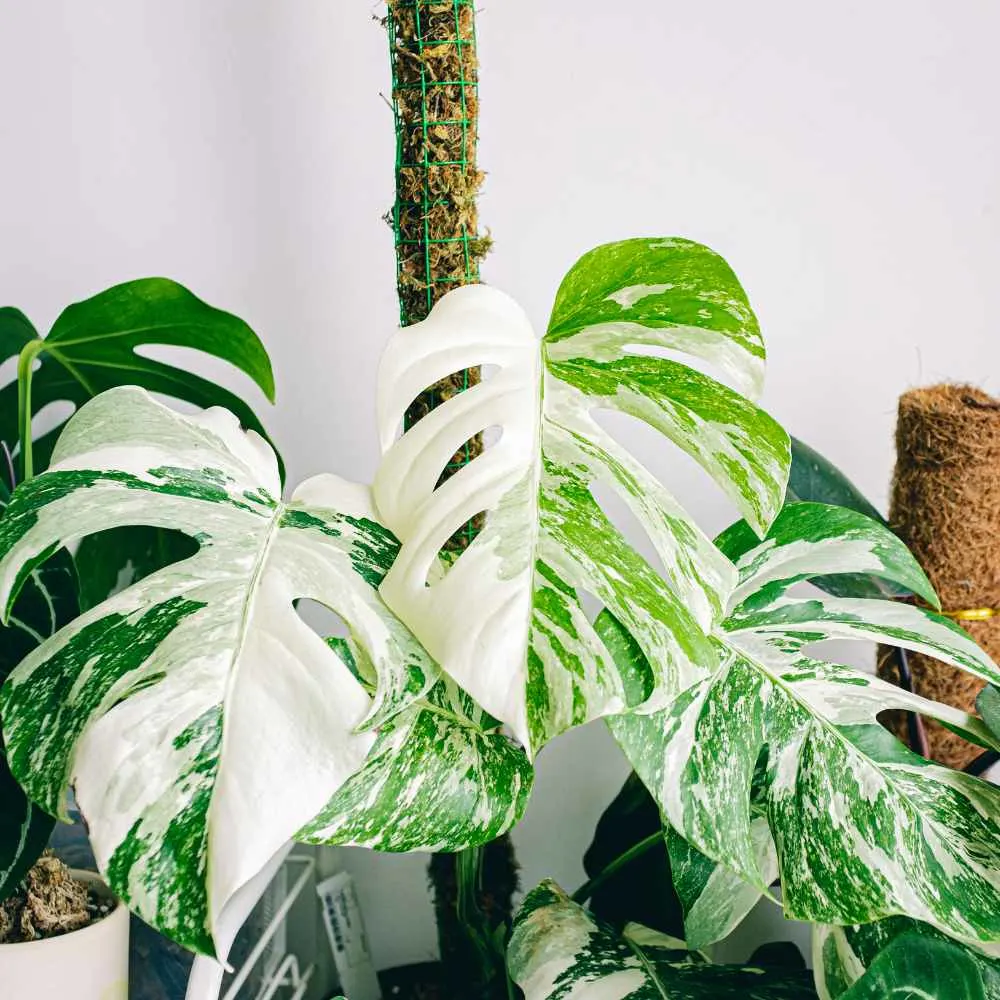
My own Albo journey started when I saw one on my social networks. I was instantly captivated and desperately wanted one. But could not justify the expense. So I craved a start that I could nurture into a lovely big Albo. My husband found a cutting on FB market place and gave me one of my most special gifts of all time. Except…
…This began one of my most frustrating and heart breaking of all my plant experiences. Over the course of six months, I tried everything I could think of, or learn from google to get this cutting to grow. The plant tried and endured quite a bit with occasional glimpse of success.
But in the end it could not survive our dark winter, water propagation, (the root kept rotting) … and my toddler son (he knocked it off a table and broke the root clear off) 🙁
Sourcing the Monstera Albo:
These plants are difficult to source and this Monstera price is high. To purchase a small started plant with a leaf or two, expect to play 300$ and up. OUCH.
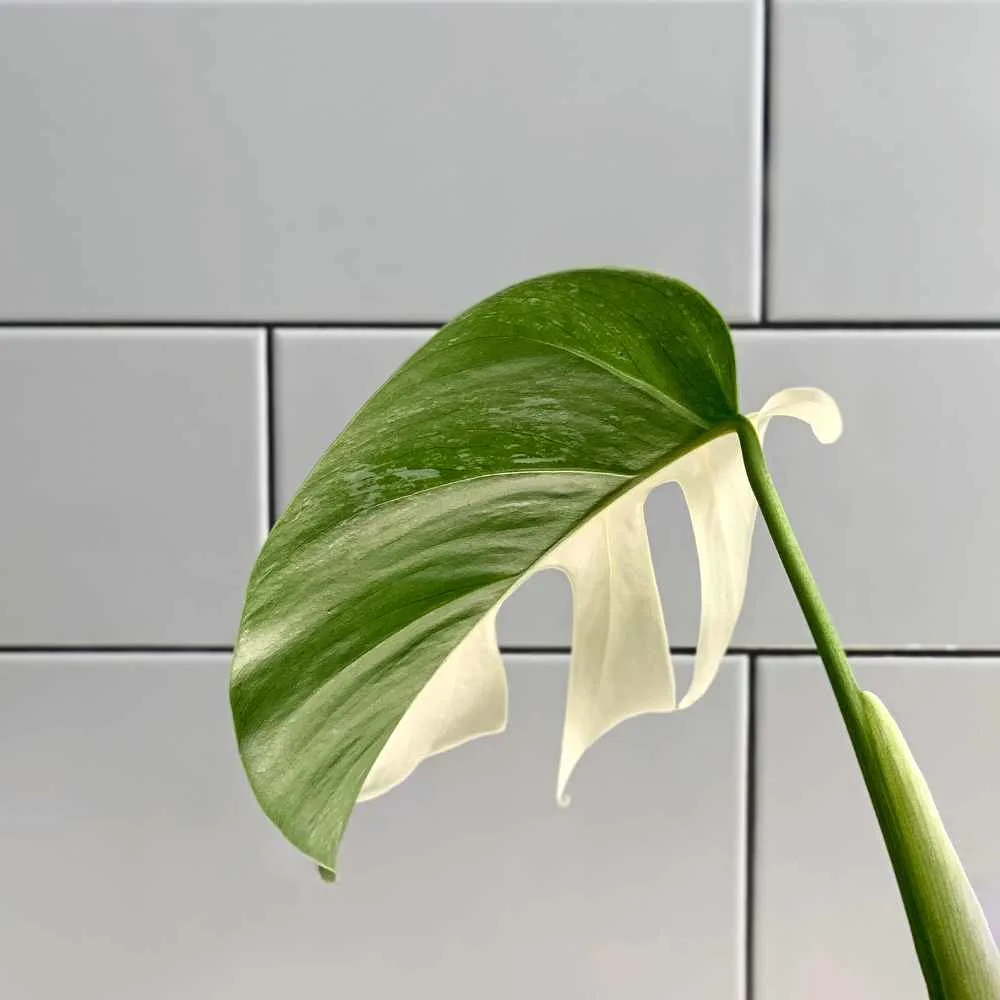
You are looking at about $150 and up for a LEAF with a root and a node. My albo came as a stem with a leaf, root and node. Even with all those healthy parts it did not grow into a plant.
Why are monstera albo so expensive? Because the monstera albo cannot be massed produced and they are in HIGH demand. These amazing plants can only be propagated by tissue culture. Like the birkin philodendron and other plants, the Albo’s are a result of chimeric spontaneous sport variegation.
To propagate the variegation, a stem cutting must be sourced from a leaf node that is striped and shows promise of producing the variegation. Then you have to hope the plant reproduces the variegation throughout its leaves and does not revert back to solid green. It’s tricky.
Purchasing a rooted node that is showing white stripes on it is around 100$ or less. If you can get it to grow, it will likely give you the coveted variegated Albo leaves.
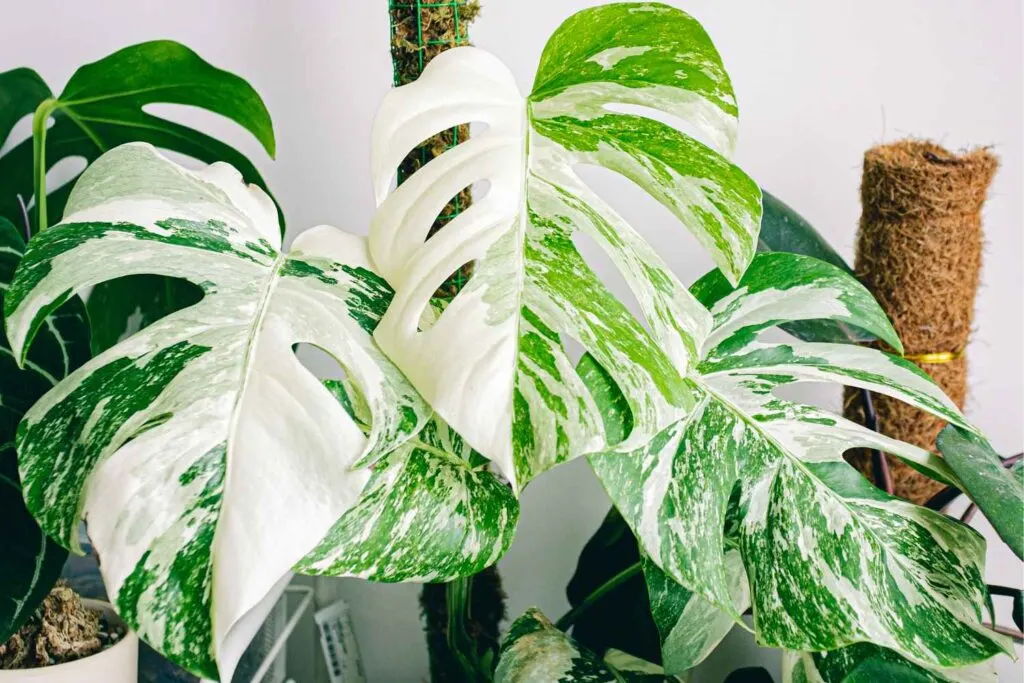
Chimeric sport variegation means a nursery has MUCH more time and care involved in producing the Albo monstera than it’s easily grown solid green Deliciosa parent. You’re not likely to find an albo monstera at a local garden shop. But they do pop up quite by accident, rarely, in garden shops. Since this is a sport variegation, a green plant can spontaneously produce it. You may get lucky.
However, your best bet for finding a Monstera Albo for sale is too look for small WELL REVIEWED growers on ETSY, Instagram, or FB market place.
The prices they ask are not out of line considering what they go through to produce these plants for you. 🙂
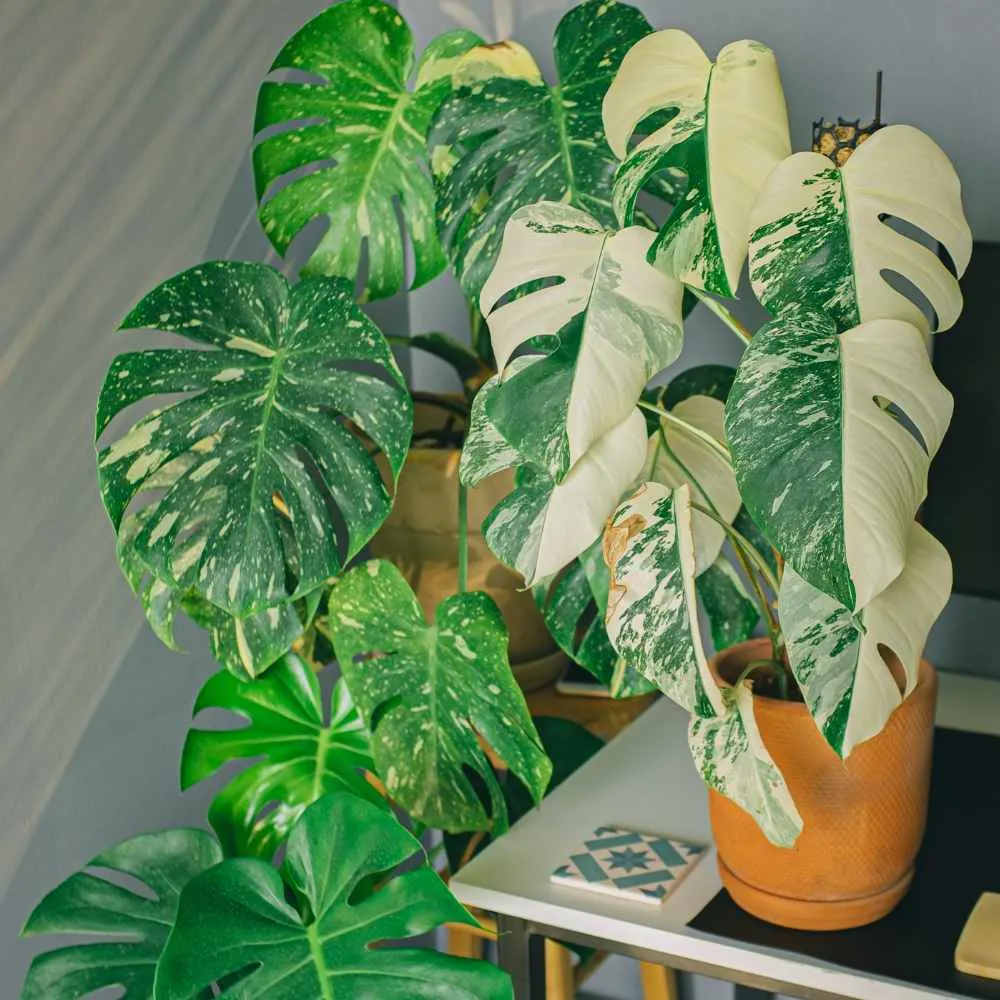
Albo Monstera Plant Care Tips:
Read our printable guide at the bottom of this post for more details on caring for your precious Monstera Albo. For a quick, ‘at a glance’ look at the care needs of this plant we’ve produced this table for you.
| Familiar Names: | Monstera albo, Albo Monstera, monstera albo variegata, |
| Scientific Name: | Monstera deliciosa ‘Albo Borsigiana’ |
| Plant Family: | Araceae |
| Care Difficulty: | moderately easy |
| Temperature: | Albo is happiest indoors at 65 to 80 degrees F. Plant outside in Zone 9 to 11. |
| Watering: | Overwatering will cause root rot. Water when soil is dry down 2 inches or every other week. Soak the plant and allow water to drain away. |
| Humidity: | Monstera Albo humidity should be around 60% humidity. Follow the tips in our printable guide to control humidity around the plant. |
| Soil: | The best soil for monstera Albo is light friable soil that allows the water to drain well. Our homemade soil mix in our printable guide below works well for this plant. |
| Fertilizer | Monstera Albo Fertilizer should be a general purpose balanced fertilizer applied monthly during the growing season. |
| Lighting | Monstera Albo Light Requirements are vital to the successful growing of this lovely variegated vine. Bright Indirect or dappled light will help the variegated leaves grow their best. Direct sunlight for long hours of the day will burn leaves. Low light can cause leaves to revert to solid green. |
| Growth Habit | This plant grows as a vine. it does best when staked on a moss pole or other supporting structure. |
| Pruning | Light pruning off of old leaves or some shaping is all this plant needs. |
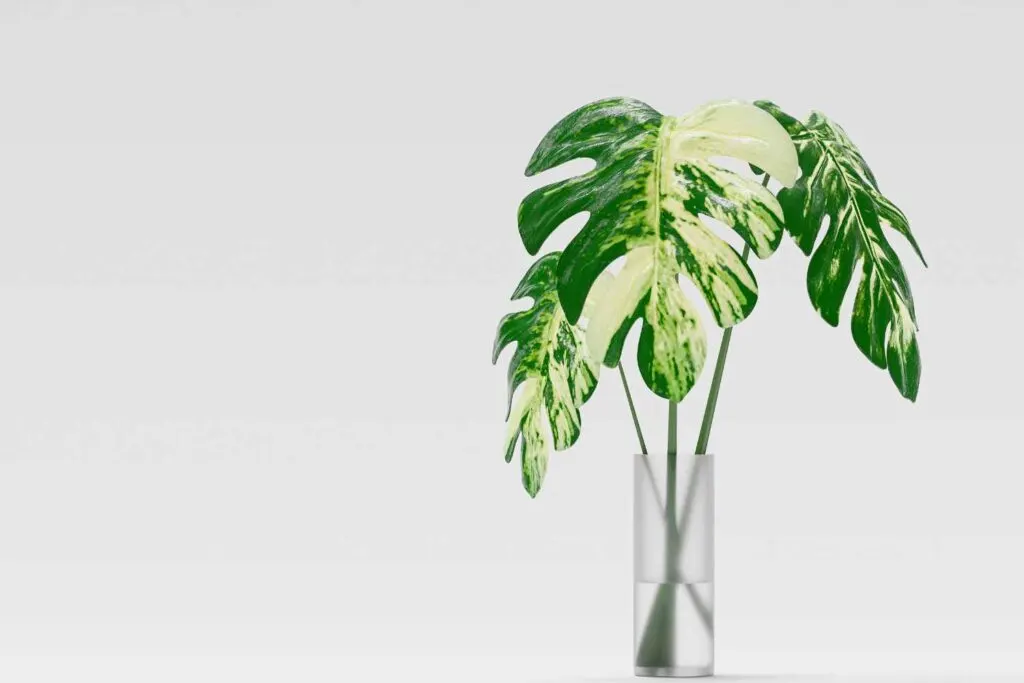
Propagating Monstera Albo:
Can you propagate monstera albo from seed? you can source seeds from plant growers for the solid green deliciosa monstera and grow those. A spontaneous sport variegation MAY occur. If you want to really play the odds, you can start a bunch of deliciosa seeds for around 20$ and hope you get a sport variegation out of them. I tried this. Read my post on How to grow a Monstera plant from seed. It works great. but I have not seen any substantial variegations in the leaves yet.
Chimeric Tissue Culture: In order to reliably get the variegation on the leaves we covet, you must take a stem cutting from a variegated plant. The cutting must have stripes showing up the stem and through the leaf nodes to be a good candidate.
WATER Propagation: The cutting is quite simple to grow in a vase of clean water. It will take several weeks to actually start to grow new roots and leaves. And the roots may rot in the water. (mine did).
Sphagnum Moss: You can also dip the roots into root hormone and set it into sphagnum moss. This allows more air to the roots and less likelihood of rot. but the root may not grow. Mine eventually started to before its terrible accident.
There is really NO other plant I’ve found that has the visual impact of this one. These variegated Deliciosa albos are just amazing and not really hard to grow.
Reverting:
Can the albo Revert back to solid green like its mom plant the deliciosa? Yes. The albo monstera is light sensitive. All variegated plants must have more light and good nutrients from good soil and fertilizing practices to feed them.
This is true because those large white patches cannot feed the plant. In nature these variegations reduce photosynthesis and are a big problem. A plant with large white patches on the leaves will usually not survive. The plant will protect itself by producing solid green leaves.
In your home be SURE to follow these Care tips for the best plant health. The Albo has a LOT of variegation in the leaves to overcome. Feed it and give it lots of filtered light.
Monstera Albo
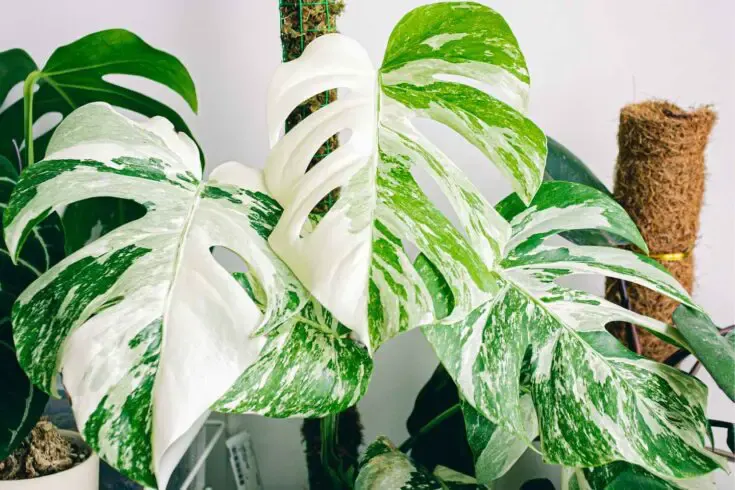
The Monstera Deliciosa Albo is a large lovely variegated vine that grows up to 10 feet long indoors. It has beautiful green leaves with holes (fenestrations) and large patches and stripes of unique variegations. The color and texture of this magnificent plant make is a show stopping stunner in your home.
This Care Guide will teach you how to keep this houseplant happy all through the year.
Materials
- Orchid bark
- Peat moss
- Perlite
- General potting soil
- mask
- Fertilizer
Tools
- Pot (ceramic, plastic, or terra cotta)
- Potting medium (perlite, soil, peat moss, and orchid bark)
- Scissors
- Rubbing Alcohol
Instructions
Soil Preference:
- All Monsteras prefer well draining soil. The roots requirs lots of oxygen and will rot quickly if they sit in moist soil.
- A homemade aroid soil mix of 1/2 potting soil and 1/2 peat moss or coco fiber is a good mix for monsteras. Add bark or perlite for an even lighter mix.
- Make sure your pot has drainage at the bottom. Do not use a pot with no drainage hole for this plant.
- A heavy soil potting mix is not recommended for Monsteras
Pot Size and Type:
- The monstera Deliciosa can grow in many different kinds of pots, I like to plant mine in terra cotta pots with a drainage hole.
- Monstera Deliciosa's do not like to be root bound
- Repot every second year or when roots come out the drainage holes on the pot bottom. Don't jump to a huge pot from a small one. Just go to the next size up pot for the root ball. Too much soil around the root ball invites wet soil conditions and root rot will follow.
Moss Poles and Trellising:
Your Deliciosa albo will enjoy growing on a moss pole so it can be fed and moisturized as it climbs. This will give you both excellent leaf growth and plant size. Eventually you will need a well anchored good sized pole.
Lighting:
- This monstera will be happiest in BRIGHT indirect light. You will not see optimal leaf fenstrations or variegations unless the plant has the proper light conditions.
- Bright filtered sunlight from a window will produce best color, leaf size and plant growth.
- Make sure the plant isn't sitting in constant direct sunlight. The leaves can burn and yellow.
Watering:
- Water your monstera when the soil is dry at least an inch or more down. These aroid plants are typically drought resistant and can withstand longer periods of dryness compared to other houseplants. Every two weeks should be fine.
- Watering is best done on a regular schedule so the plant is not over or under watered. Both can cause stress on the plant.
- In dormant winter months reduce watering to when the soil is dry at least halfway into the soil.
- Never let this plant get wet feet. This plant is susceptible to root rot and fungus gnats in heavy moist soils.
Humidity Tips:
Like all monstera the Deliciosa albo enjoys a humid environment. Keep the plant at 60% humidity or higher for best growth and hydration. Here are some ways to do that.
- Set it on a large pebble tray with water in it.
- give your plant room a good sized humidifier.
- Group plants together so they respire together and keep the humidity up.
- Use a hygrometer to monitor the humidity and check it often.
How to Fertilize:
- Apply a good quality fertilizer (linked in materials) monthly through Spring and summer.
- Decrease feedings by late Fall and allow this plant to rest through the winter months.
Temperature:
- The monstera plant will do best in temperatures between 65-85 degrees F.
Leaf Washing:
Monstera plants benefit from monthly leaf washing to dust the leaves and wipe any pests off. This also open the leaf stomata so the leaf can absorb moisture and respire oxygen to your room.
1 1/2 Tsp. Neem oil to a quart of distilled water is a good solution for applying directly to the leaves to deter pests. Wash both the top and bottom of the leaf.
Pests:
- This monstera is a hardy resilient plant. However all plants can get attacked by pests.
- Stress by longterm overwatering, poor light, extreme temperatures and soil conditions are contributors to plant stress..
- Spider mites, mealy bugs, scale, thrips and whitefly are the most common houseplant pests you will see.
- Read our post on How to get rid of aphids and other pests with our homemade pesticide soap recipe or neems oil.
- To minimize the possibility of pests be sure to check all nursery plants before bringing them home.
- Quarantine all new plants until you are sure no pests live in them.
How to Propagate:
The type of variegation of this plant is a spontaneous sport variegation. This means the plant will not breed the variegation to new generations. For this reason a stem cutting from a variegated plant is the only way to ensure your cutting will also grow a variegated plant.
Stem Cuttings:
To retain the variegation you must propagate a variegated albo with a node that grows a striped stem.
- Cut stem in the internodal spacing using sterile scissors
- Place in water or wet spagnum moss with nodes and stem down in the water or moss and the leaf up.
- After several weeks roots will grow
- Plant in soil when roots are 2-3 inches long
Planting From Seed:
Read my post and watch my video series on how to propagate monstera from seeds.
Toxic Plant Warning:
All Monstera plants are toxic. Keep them away from kids and pets.
Notes
This plant does best when trained onto a moss pole or trellis so it can climb. Watch the video below of us repotting and staking our raphidophora tetrasperma for tips on repotting climbing aroids.
More Incredible Monstera Plants:
Monsteras are always an impressive addition to your home or office. The large leafy vines are showy and easy to care for.
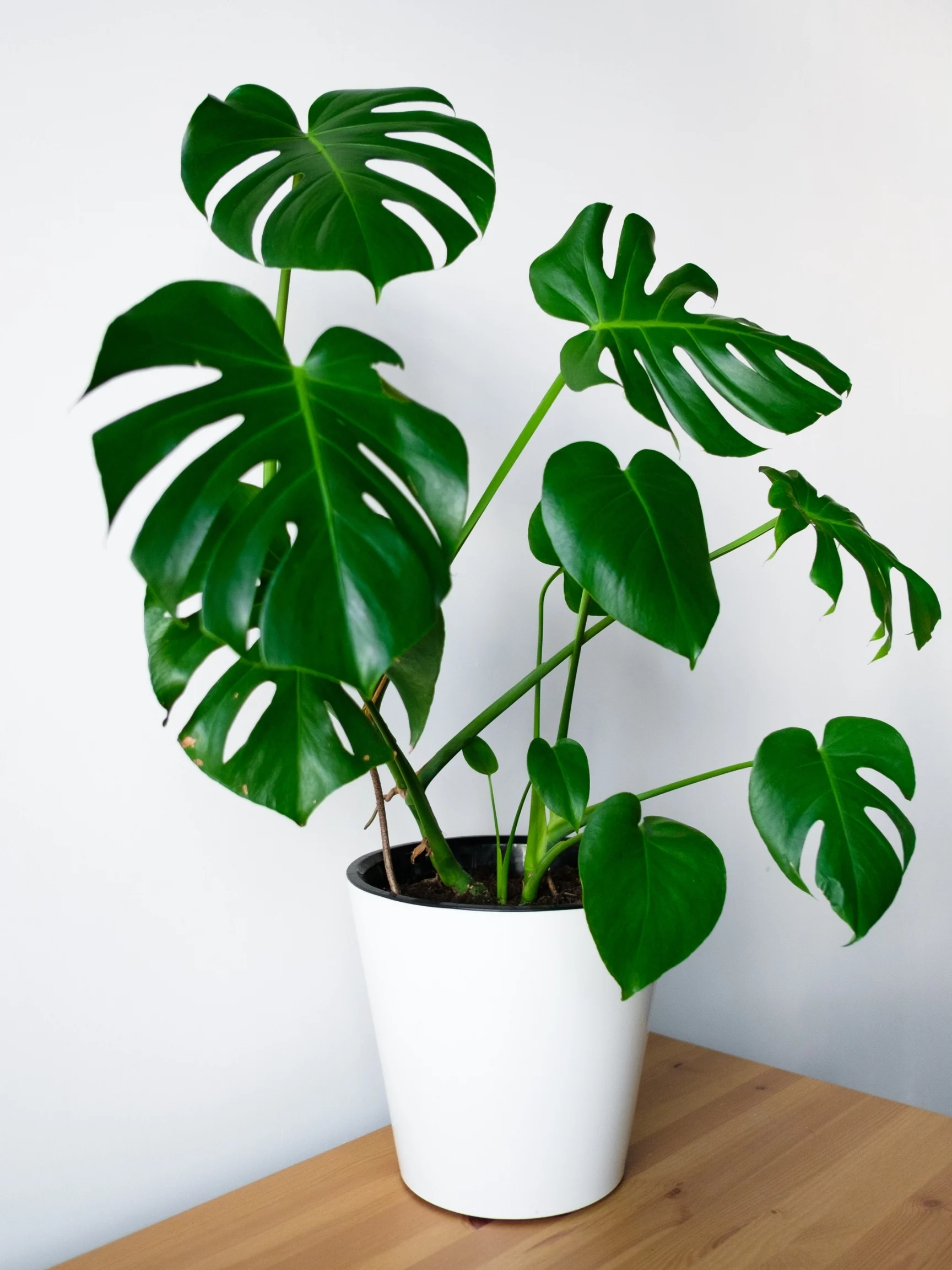
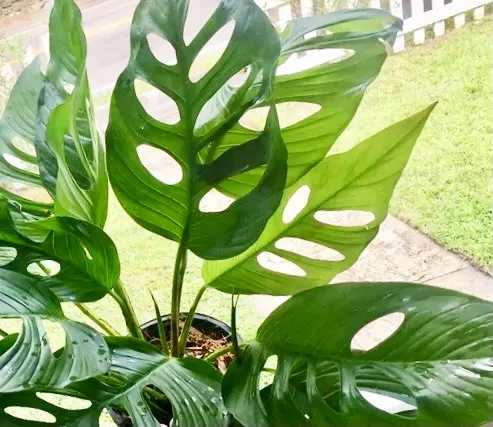
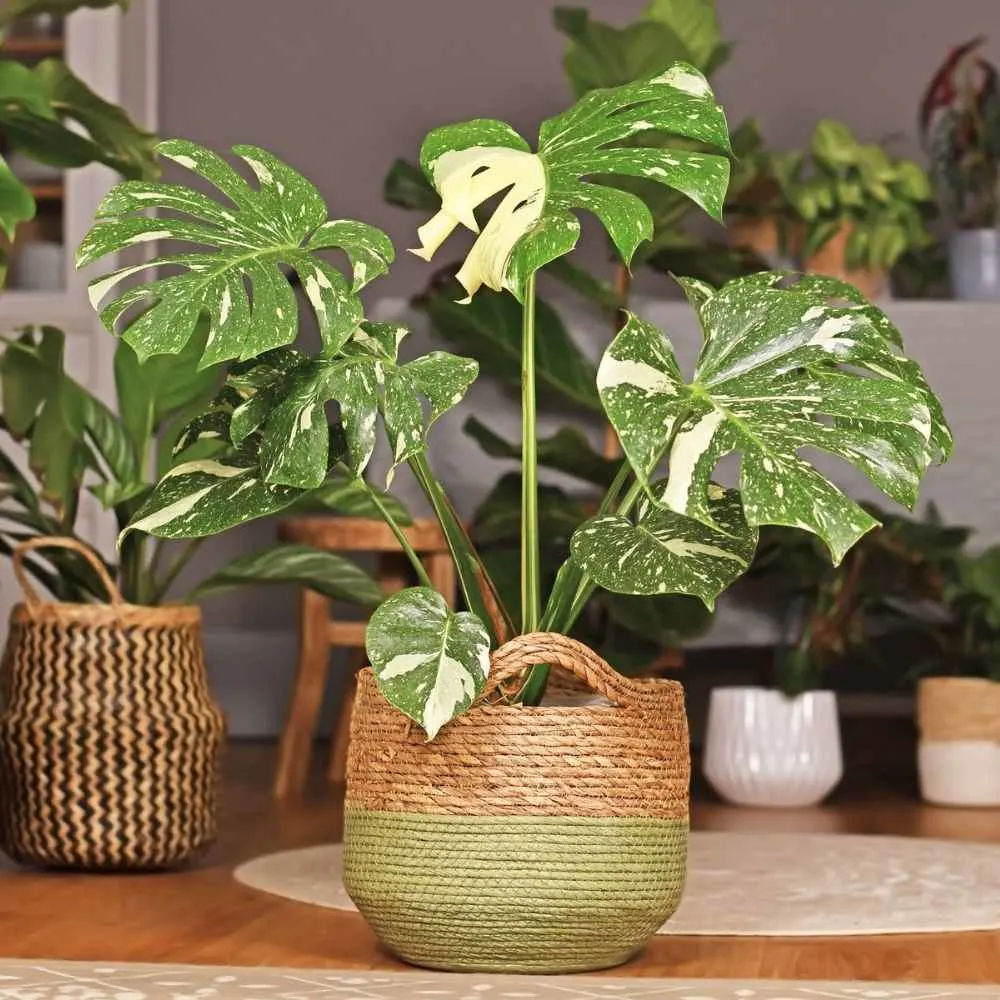
Related Content:
Follow Us:
Find us on YouTube, Instagram , Pinterest and TikTok! We love to Plant chat. We also comment, like and occasionally share your content to our daily stories. We’d love to see your plants. Share your joy in your houseplants. Happy Planting!



Jay
Wednesday 22nd of March 2023
Hi! I sent you an email about this page :)
Diane Williams
Wednesday 22nd of March 2023
Thank for alerting us Jay. Reply is on the way. :)